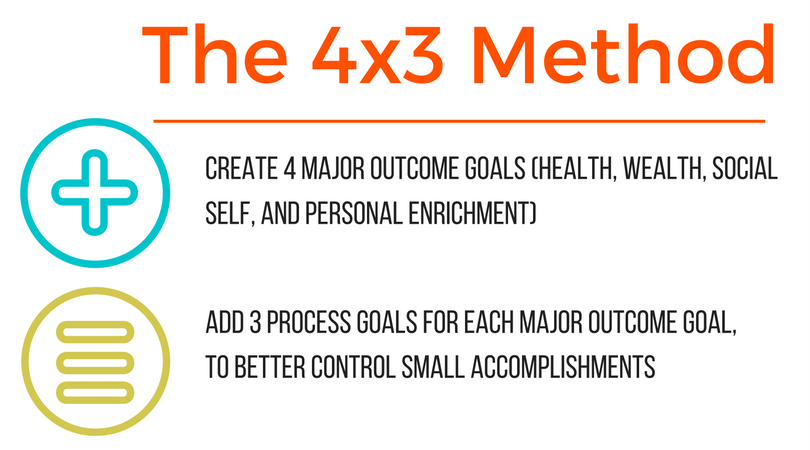The Ultimate Guide to Successful Goal Setting

Have you ever tried goal setting but failed to achieve the end result?
This could come in the form of a New Years Resolutions, sales plan, or health objective.
I was once like that, but fortunately, my mentor Mark Ford showed me the big mistake that I was making when it came to setting goals.
I was setting too many goals. It was a shotgun-scattered approach. I was trying to do far too many things at once. Weeks went by, and I didn’t feel a sense of accomplishment.
Ford then taught me a new set of rules for successful goal setting. This was one of the biggest breakthroughs in my career and has helped me become financially independent for the past 20 years.
In this Ultimate Guide, you’ll discover why you need to ditch the shotgun approach to planning your goals and start using the 4×3 approach. With this new set of rules in place, you should be able to overcome the inertia holding you back from completing your goals and furthering your life and success.
The Origins of Goal Setting
Goal setting, done the right way, is a direct process for success, happiness, wealth, and freedom. It has been for centuries, from the days of Milos in Ancient Greece, who used goal setting to gain more strength every day, to the days of conquistadors and kings searching for a route to the new world.
The greatest authors, scientists, and entrepreneurs from history all used goal setting to overcome perceived limitations and achieve faster results, making them legends.

Courtesy New York Social Diary
In the early 1900’s, steel magnate Charles M. Schwab was looking for every edge to get his workers to become more effective. His factory, running both a night shift and a day shift, was churning out steel but never fast enough for his liking. Schwab, being savvy about the potential of human motivation, recognized the power of competition and leveraged this to increase his workers’ output.
“How much steel did your team make today?” he asked his day-shift foreman.
“Six heats,” the foreman replied.
Schwab took a piece of chalk and drew a giant “6” on the factory floor.
When the night-shift team arrived, they asked what the number represented. After hearing that it was the day shift’s daily production, the night shift team took it upon themselves to outdo that number.
The next morning the number “6” had been replaced with a “7.” The day shift accepted this challenge and upped their production. They finished the day by writing “10” on the factory floor.
The mill’s production benefitted from the competitive that resides in all human beings. Schwab had recognized this, and by providing his employees with a goal, he elevated their performance and turned them into high achievers.
One of the secrets to the success of this strategy was the built-in deadline that came with each shift. After all, you’ve probably heard that a goal without a deadline is just a dream. Remember that when as you go through this Ultimate Guide to Successful Goal Setting and prepare to put your goals into hard, measurable, timed action.
What Exactly Is A Goal?
The dictionary defines a goal as:
- The object of a person’s ambition or effort; an aim or desired result.
- The end toward which effort is directed
You’ve probably set goals for school (getting an “A” on a test), for your health (losing five pounds), or your wealth (getting a raise of $5,000 or saving $10,000 by the end of the year for a holiday vacation).
Most likely, you’ve set goals on New Year’s Eve. Typically, most people forget about these goals within days, and never bother to set another goal until January comes around again, (as if there is only one time a year when humans are able to change their habits).
No. Change is evergreen, and it’s a matter of choice not calendar. You must not wait to set goals and implement the 4×3 system you’ll discover below.
Differentiate Between Goals and Wishes

One of the many mistakes people make with goal setting is that they simply make wishes, rather than setting proper objectives.
We might say, “I want to be rich,” or “I want six-pack abs,” or “I want to move to the beach,” but if we end there, we’ve done nothing but make a wish. We might daydream about having this outcome (daydreams are also NOT goals), but we’ll take no action toward it.
So how can you craft a real, actionable goal?
First, add a deadline. Second, add specificity. And third, be realistic.
To overcome the temptation to sit around wishing your life away, George T. Doran outlined the importance of objectives, the difficulty of setting them, and how to do it easier. This strategy was published in the November 1981 issue of Management Review and was dubbed the S.M.A.R.T. approach to goal setting.
“Make your goals Specific, Measurable, Actionable, Realistic, and Time-based.”
S.M.A.R.T is a good place to begin, but as you’ll see in The New Rules of Goal Setting, there’s a more efficient approach.
How the Old System Works
- Specificity: Your goal needs a number. Pick a number of pounds to shed or a dollar amount to make. Know your numbers, because you can’t argue with a hard numerical measurement.
- Measurable: With specific numbers in place, track your results over time and see where you are on your path to success, and whether or not you need to pick up the pace to hit the deadline.
- Actionable: A goal needs to be something you can take action on, and plot a direct map toward its achievement. **In the new rules, you’ll discover a proven “process step plan” that helps you achieve more of your goals faster.
- Realistic: Your goal must be within the realm of your physical and mental limitations. Otherwise, no matter how good of a plan you build, you’ll be disappointed. For example, you can dream about winning a Gold Medal in swimming at the Olympics, but unless you’re young enough, talented enough, and willing commit your life to the process, then it’s not going to happen. However, you can set a realistic goal to improve your swimming performance and follow daily action steps to get there. The same goes for building your wealth. It’s unrealistic to go from broke to millionaire in 30 days. But you can get out of debt, get a raise, and build your wealth within 90 days.
“While it’s important to not set the bar too high, it’s just as important not to set the bar too low,” Mark Ford said. “If you feel scared by your goal but still feel that you can accomplish it, that’s when you know you have set the bar at an appropriate level.”
- Time-Based: Having a clearly defined plan includes a hard deadline for completion. A time-based goal lights a fire under your butt to take action.
“When you set a deadline, that’s when the magic really begins to happen,” Mark Ford added. “Committing to a 12-week body transformation, or being worth $1 million in seven years, or going on your dream vacation to France in the next three years are examples of correct goal setting.”
The New System Works (Better)
While almost everyone has set a goal in the past, few take the essential step to write them out. Even fewer reflect back and review and renew these goals on a regular basis. That’s what the new rules will correct in your goal-setting process.
Creating clear, concise, and specific goals with a deadline, tracking your performance over time, and reflecting on how you can do better are the keys to getting ahead.
Goal setting could increase productivity up to 25%
Research in the late 1960’s showed that setting goals increases motivation, performance, and productivity. One study, by University of Toronto psychologist Gary Latham and University of Maryland psychologist Edwin Locke discovered that goal setting could increase productivity up to 25%. That means having a goal for your workday can help you get 10 hours of work done in just eight (or eight hours of work done in just six, allowing you to knock off early for the day).
It has also been uncovered that the key to greater success and dramatic improvements in productivity depend on you setting BIG goals with a deadline. But there’s a catch. You have to be committed. You have to believe in what you’re doing.
Speaking of deadlines, do you know what you want to accomplish in the next 24 hours, 4 weeks, 90 days, and 12 months? That’s the power of creating a Life Vision.
Learn how to create your Life Vision in this Ultimate Guide. Once you’ve created your vision, you should have a clear and concise picture of what you want your life to look like.
Big Goals V. Small Goals
Goal setting is an important ingredient in becoming more successful. It can help you write a book faster, sell more goods and services, or complete manual labor in less time. When you set big, specific goals that matter to you, then you become more effective and more willing to be persistent (even if you are struggling). When you have clear and specific goals, your brain can focus better on the task at hand, and the reward to follow in the long run. This leads to elevated concentration, stronger motivation, fewer distractions, and a deeper commitment to action.
Big goals can span months or even years into the future. But the problem with setting big goals like that is that can the long time frame can lead to procrastination. In order to start taking fast action, you need to work backward from your big ambition to your first action step. I call this Reverse Goal Setting.
So in addition to setting big goals, you also need to create a subset of smaller, actionable goals to outline your path to success while eliminating the chance of failure. These are known as process goals and are an important part of the 4×3 goal setting formula you’ll learn below.
How to Add Process Goals

Start by setting four major outcome goals (these are the big goals that we don’t have total control over… we’ll talk more about these below).
Then, taking into account the many external factors that play into major outcome goals— for example, if you sprain your ankle while training for a marathon goal— add process goals to better control small accomplishments on the road to outcome goals.
Imagine a staircase. The landing at the top represents your outcome goal. The steps to get up to that landing represent your process goals. No matter what happens, you have the power to climb those steps. And while the landing might be out of reach, you can feel satisfied knowing you climbed as high as you were able.
“Applying this idea in our daily life means breaking tasks into bite-size chunks, and setting goals accordingly,” said Ford. “Think challenging, yet manageable—just enough stimulation to shortcut attention into the now, not enough stress to pull you back out again.”
This formula can help inform how to spend your dedicated process goal time:
- Dedicate 25 percent of your allotted time to studying.
- Dedicate 25 percent of your allotted time to observing.
- Dedicate 50 percent of your allotted time to DOING!
Doing, Mark Ford says, is the most important part.
“When you are dedicating yourself to achieving a specific goal, you must promise yourself to use the time you’ve blocked off for it ONLY for working toward that goal,” Mark said. “Avoid mental and physical distractions. If for example, you start thinking about your job, family, friends, or the party you’re hosting next weekend during the block of time you’ve scheduled for learning golf, you’re stealing time from your goal.”
That being said, your process goals aren’t simply consolation prizes. They should be set in a manner that all but ensures you achieve your outcome goal.
The new rules of goal setting outline that you should set three process goals for each of your four outcome goals. Hence rounding out the 4×3 method of goal achievement.
Let’s say you want to write a book within the year. Well, a book is about 60,000 words, meaning with that deadline you need to write 500 words, six days a week, for 20 weeks. Isn’t that manageable and more concrete when you look at it that way, compared to wishing for a book to magically write itself in 365 days?
Here are the process goals you would set to achieve this outcome goal:
- Each day, write 500 words first thing in the morning.
- Each night, outline the next day’s writing.
- To hold yourself accountable, pay a $20 fine – to a cause you dislike – for every day you do not complete these process goals.
Now, if you hit those process goals, all of which are within your control, then you’ll have a book in 20 weeks. That’s how powerful this simple process can be.
How to Stay Focused on Your Goals
We’ve talked about sourcing your powerful motivation, and instilling accountability checks that act as consequences if your process goals are incomplete, but what else can be done to stay focused?
Writing down your goals is a great start. Regularly reviewing them is the cherry on top.
“A recurring habit among very successful people is that they know exactly what needs to be done when they get up in the morning,” Ford said. “They plan their days ahead of time so they can get to work on the most important tasks immediately in the morning.”
 Try this exercise:
Try this exercise:
- Think about your No.1 priority in life. It might be improving your health, writing a book, getting out of debt, or growing a relationship.
- Now write down what you do in the first hour of your day.
Are these actions in alignment with your top priority?
Or are you wasting time on trivial matters when you should be making progress? What obstacles do you need to eliminate? What habits and rituals can you put in place to move ahead in pursuit of your outcome goal?
Now make one big change today to align your actions with your goals.
Staying focused is one of the biggest challenges related to goal setting, Ford attests, and if you can’t focus on doing it won’t matter how many hours you spend on planning.
That’s why you must only have four major goals, and each major goal needs to have three process goals (the 4×3 system).
How Many Goals Should I Set? The Magic Number…

Four.
After Ford saw that I was setting too many goals, he sat me down and said, “You should only be setting four major goals, one for each of the important areas in your life.”
He told me to picture a bulls-eye. In the center are your four major goals. Surrounding the bulls-eye are the outer rings, representing other areas in your life. When you hit the bulls-eye, meaning when you accomplish your major goals, everything outside of the bulls-eye improves.
Write down a single goal for the year in four areas of life:
- Health
- Wealth
- Social Self
- Personal Enrichment
Wealth is obvious: Whether you want to make more money this year or build a nest egg of a certain dollar figure, it’s easy to quantify your wealth goal. But keep it simple and specific. Pick only one that matters the most.
Health is also simple to understand: Whether you want to lose 10 pounds of fat, gain 10 pounds of muscle, or take up meditation to reduce your stress, health goals are obvious. Again, focus on one big health goal that dictates how you’ll do in all the other areas.
Pick a goal for your social self: This refers to your relationships in life. It could be focused on finding a love interest, making friends when you move to a new city, or re-building a family connection that has gone sour.
Choose a goal for your personal enrichment: This refers to you getting smarter or giving back to your community through charity work.
Reviewing Your Goals
Reviewing your progress in all four major goals is a key to achieving success and maintaining the momentum of goal setting- goal working- and goal achievement.
In the weight loss world, research shows that people who weigh themselves every day keep the weight off longer than those who don’t. Likewise, Mark Ford’s extensive study of millionaires has found the same thing for wealth building.
“If your goal is to become wealthy,” Mark wrote in his book, Automatic Wealth, “it’s a good idea to track your net worth on a regular basis. Specifically, I suggest that you do a personal balance sheet every month. Create a spreadsheet that lists all your assets and all your debts. Include valuable possessions, stocks, bonds, mutual funds, gold, real estate (aside from your home), and so forth. You’ll be amazed at how much this simple commitment can affect the way you think and even the way you act.”
Studies find the same thing to be true of goal setting: If you write down your goals and check them regularly, you’ll have a much better chance of achieving them.
For instance, a recent study from Day Timer concluded that American workers with the highest incomes and most successes in the workplace are those who have written goals.” On the flipside, of the more than 70 percent of workers who don’t write down a career or financial goals, only nine percent accomplish what they set out to do each day.
Conclusion
With the right number of goals and new rules in place to achieve them using the 4×3 system, you can make a plan to steer your life in the direction you want.
And isn’t that beautiful?
